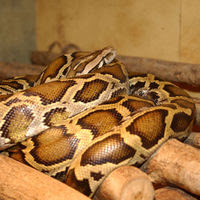The Burmese Python (Python molurus bivittatus) is the largest subspecies of the Indian Python and one of the 6 biggest snakes in the world, native to rain forest areas of Southeast Asia. They are often found near water and are sometimes semi-aquatic, but can also be found in trees.
The Burmese python is one of the largest of all snakes, growing up to 25 feet and weighing up to 400 pounds. It continues to grow throughout life and the great length is due to the presence of a large number of vertebrae. Females are typically larger than males.
A Burmese Python at Serpent Safari Park in Gurnee, Illinois, USA. holds the record for heaviest living snake. As of 2005, it weights of 182.76 kg (403 lb) at a length of 8.23 m (27 ft).
The Burmese Python is found throughout Southeast Asia including Myanmar, Thailand, Vietnam, China, and Indonesia. This python is an excellent swimmer and needs a permanent source of water. It can be found in grasslands, marshes, swamps, rocky foothills, woodlands, river valleys, and jungles with open clearings. They are good climbers and have prehensile tails.
Wild populations are considered to be "threatened" and are listed on Appendix II of CITES. All the giant pythons (including the Indian Python, the African Rock Python, and the Reticulated Python) have historically been slaughtered to supply the world leather market, as well as for folk medicines, and captured for the pet trade. Some are also killed for food, particularly in China. In more recent years extensive captive breeding of the Burmese Python has made the importation of wild caught specimens for the pet trade uncommon.

Burmese Pythons are light-coloured snakes with many dark brown blotches bordered in black down the back. Their perceived attractiveness of their skin pattern contributes to their popularity with both reptile keepers and the leather industry. The pattern is similar in colour, but different in actual pattern to the African Rock Python (Python sebae), sometimes resulting in confusion of the two species outside of their natural habitats.
source : wikipedia












